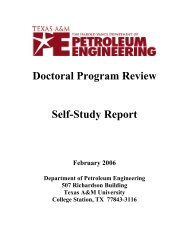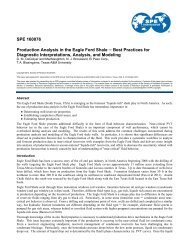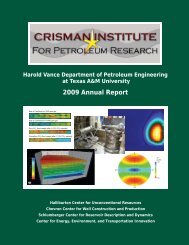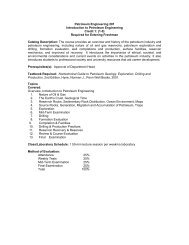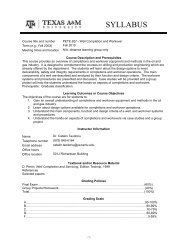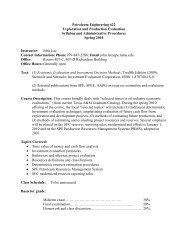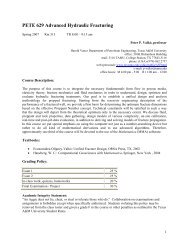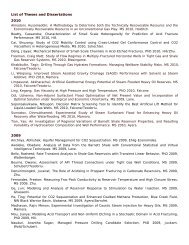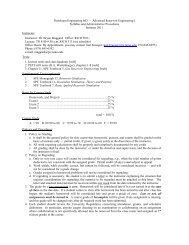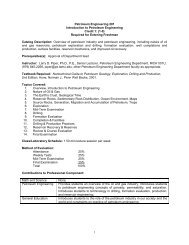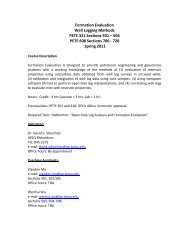Shell Drilling and Production Camp â Robert, LA Briefing Pack 2008 ...
Shell Drilling and Production Camp â Robert, LA Briefing Pack 2008 ...
Shell Drilling and Production Camp â Robert, LA Briefing Pack 2008 ...
Create successful ePaper yourself
Turn your PDF publications into a flip-book with our unique Google optimized e-Paper software.
<strong>Shell</strong> <strong>Drilling</strong> <strong>and</strong> <strong>Production</strong> <strong>Camp</strong> – <strong>Robert</strong>, <strong>LA</strong><br />
<strong>Briefing</strong> <strong>Pack</strong> <strong>2008</strong> - 2009<br />
<strong>Shell</strong> <strong>Drilling</strong> <strong>Camp</strong> Breifing <strong>Pack</strong> <strong>2008</strong>-2009.doc
CONTENTS<br />
1. Welcome<br />
2. Guide for Participants<br />
3. Travel Information<br />
4. General Safety Information<br />
5. Contact Information<br />
<strong>Shell</strong> <strong>Drilling</strong> <strong>Camp</strong> Breifing <strong>Pack</strong> <strong>2008</strong>-2009.doc
Welcome<br />
Congratulations on being invited to participate in the <strong>Shell</strong> <strong>Drilling</strong> <strong>and</strong> <strong>Production</strong> <strong>Camp</strong>. Thank you for<br />
deciding to take time out of your schedule to find out more about what <strong>Shell</strong> can offer. This guide is<br />
designed to provide an overview of the camp, its purpose <strong>and</strong> the people who will be involved during the<br />
day.<br />
Why do we hold these camps?<br />
The <strong>Shell</strong> <strong>Drilling</strong> <strong>and</strong> <strong>Production</strong> <strong>Camp</strong> invites 40+ students <strong>and</strong> faculty members from various universities –<br />
as guests of <strong>Shell</strong> – for a week-long program at the <strong>Shell</strong> <strong>Robert</strong> Training & Conference Center where they<br />
are exposed to the latest in subsea operations, state-of-the-art drilling techniques, <strong>and</strong> other practical<br />
training, including Health, Safety, Security <strong>and</strong> Environment.<br />
<strong>Shell</strong> is at the heart of the energy <strong>and</strong> petrochemical business <strong>and</strong> one of the world’s most successful<br />
companies. Developing our business successfully into the 21st century <strong>and</strong> beyond will bring tremendous<br />
challenges with it:<br />
• Continually stretching what is possible technologically,<br />
• Enhancing the range <strong>and</strong> quality of products <strong>and</strong> services that <strong>Shell</strong> provides to the 20 million<br />
customers we serve daily,<br />
• Introducing ever more environmentally friendly technologies into our existing core businesses of<br />
Exploration <strong>Production</strong>, Oil products <strong>and</strong> Chemicals manufacturing,<br />
• Developing <strong>and</strong> commercializing more sustainable forms of energy such as solar or hydrogen<br />
power, operating in increasingly global markets without losing the ability to adapt to local<br />
circumstance <strong>and</strong> cultures.<br />
The quality of <strong>Shell</strong> people has always been, <strong>and</strong> remains, a cornerstone of the <strong>Shell</strong> Group’s strategy to<br />
meet these challenges, <strong>and</strong> our recruitment of individuals from universities provides a key source of new<br />
talent. For this reason, <strong>Shell</strong> places great importance on the quality of its recruitment process <strong>and</strong> has<br />
designed the <strong>Shell</strong> <strong>Drilling</strong> <strong>and</strong> <strong>Production</strong> <strong>Camp</strong> with these objectives:<br />
• Firstly, to provide operations, craft <strong>and</strong> technology students the opportunity to experience <strong>Shell</strong>’s<br />
operations environment.<br />
• Secondly, to provide you with the best opportunity possible to demonstrate the skills <strong>and</strong> qualities<br />
you would bring to our businesses.<br />
• Finally, to allow you a window into the world of young professionals within <strong>Shell</strong>.<br />
What do we look for in c<strong>and</strong>idates?<br />
Your academic record was one key factor in asking you to join us. Our experience <strong>and</strong> research on<br />
successful professionals has, however, shown that academic skills alone are rarely sufficient to be successful<br />
within a company as challenging, dynamic, diverse <strong>and</strong> global as <strong>Shell</strong>. We have identified the following<br />
qualities as critical to high performance during professionals’ early years in <strong>Shell</strong>, <strong>and</strong> it is these qualities<br />
that we look for in potential employees.<br />
Capacity – Analyzes critical issues; identifies links; sees the wider implications; shows creativity; develops<br />
<strong>and</strong> assesses options for solutions.<br />
Achievement – Sets goals <strong>and</strong> targets; exhibits enthusiasm <strong>and</strong> motivation; deals effectively with obstacles;<br />
delivers results; deals with change <strong>and</strong> uncertainty; drives own development <strong>and</strong> learning.<br />
Relationships – Communicates clearly; influences others; identifies key stakeholders; works well on a team;<br />
works effectively with different people; supports other team members.<br />
For those individuals wishing to pursue a technical career in <strong>Shell</strong>, we are also interested in your technical<br />
ability.<br />
Please note: Whilst a basic level of English is required to participate in the <strong>Shell</strong> <strong>Drilling</strong> <strong>and</strong> <strong>Production</strong><br />
<strong>Camp</strong>, English ability is not a selection criteria in our recruitment process.<br />
<strong>Shell</strong> <strong>Drilling</strong> <strong>Camp</strong> Breifing <strong>Pack</strong> <strong>2008</strong>-2009.doc
Guide for Participants<br />
Dress code<br />
Casual “student wear” is acceptable for class; however, it’s possible that members of <strong>Shell</strong>’s executive<br />
leadership team may be in attendance during the week. So it’s advisable to be comfortable, yet presentable.<br />
You should bring bathing suits for the “Water Survival” course as well as for recreation. Be sure to dress for<br />
the weather, as it can be unpredictable. For example, it can be cool in the classrooms, so bring clothes for<br />
both hot <strong>and</strong> cold weather (i.e. jeans, shorts, t-shirts <strong>and</strong> sweatshirts). You may also want to bring a coat or<br />
jacket.<br />
You should also bring personal care products, like toothpaste, shampoo <strong>and</strong> soap. Towels are provided, but<br />
you may bring your own.<br />
Note: Wireless Internet connection is available for those with laptops. Be sure to bring your camera or video<br />
camera if you would like to record your experience.<br />
Special diet<br />
If you have special dietary requirements <strong>and</strong>/or restrictions, please advise your <strong>Camp</strong> Coordinator in<br />
advance so that we can accommodate your needs.<br />
Do you consider yourself to have a disability?<br />
(NB: “A disability is defined as a physical or mental impairment which has a substantial <strong>and</strong> long-term<br />
adverse affect on your ability to carry out normal day-to-day activities, such as those involved in mobility,<br />
manual dexterity, physical co-ordination, speech, hearing, eyesight or communication, or a permanent<br />
condition which is controlled by medication.”)<br />
If “Yes,” <strong>and</strong> you would like to provide additional information, to enable <strong>Shell</strong> to offer you the provision of<br />
any “reasonable adjustments” you may need, please contact the <strong>Camp</strong> Coordinator.<br />
Agenda<br />
Below is a breakdown of activities to expect during the <strong>Camp</strong>:<br />
• <strong>Production</strong> Operations Training – 2 days<br />
• <strong>Drilling</strong> <strong>and</strong> Well Control Training – 1 day<br />
• Health, Safety & Environmental Training – 1 day<br />
• Tour of One <strong>Shell</strong> Square – 1 day<br />
o SEPCove (<strong>Shell</strong> Exploration & <strong>Production</strong> Collaborative Virtual Equipment)*<br />
o Real Time Operations Center<br />
o <strong>Production</strong> Operations Management Center<br />
o Piping Design Room*<br />
*Availability may be limited due to business use.<br />
Course descriptions<br />
Water Survival<br />
This course covers the essentials to develop/improve water survival skills. Students practice in-water survival<br />
techniques (survival float, helicopter egress, clothing inflation, use of lifesaving equipment, <strong>and</strong> water entry<br />
from a height) in an indoor pool at RTC. Water Survival covers Helicopter Underwater Escape using a stateof-the-art<br />
helicopter simulator in an indoor swimming pool. The student learns to brace for crash/impact in<br />
water <strong>and</strong> proper escape techniques if aircraft remains on surface, sinks in upright position, or sinks <strong>and</strong><br />
rolls over to an inverted position. Students are taught techniques to deal with disorientation <strong>and</strong> anxiety.<br />
This part of the program is consistently the most memorable event of the camp <strong>and</strong> conducted with the<br />
utmost of student safety.<br />
Students do NOT need to know how to swim.<br />
Upon completion of this course the student should be able to:<br />
<strong>Shell</strong> <strong>Drilling</strong> <strong>Camp</strong> Breifing <strong>Pack</strong> <strong>2008</strong>-2009.doc
• Identify the various PFD’s <strong>and</strong> know how to use them.<br />
• Improve survival chances by applying techniques taught in the school.<br />
• Apply common sense survival/rescue strategy in an overboard incident.<br />
Health, Safety & Environmental<br />
Sessions cover proper use of common Personal Protective Equipment, safe driving pointers, fire prevention,<br />
fire fighting (h<strong>and</strong>s-on exercises with a simulator), hearing protection, ladder safety, <strong>and</strong> HSE practices<br />
common to the Exploration & <strong>Production</strong> industry. Emphasis is on topics students can use in everyday life.<br />
<strong>Drilling</strong> 101<br />
This course is designed as an overview of the operations, equipment <strong>and</strong> terminology associated with<br />
drilling <strong>and</strong> well completion operations. The session consists of classroom demonstrations of<br />
drilling/completion procedures using computer animation <strong>and</strong> simulations as well as h<strong>and</strong>s-on equipment<br />
displays. The course is designed for students who are interested in obtaining a better underst<strong>and</strong>ing of how<br />
wells are drilled <strong>and</strong> completed.<br />
Upon completion of this course participants should be able to:<br />
• Describe how a well is drilled, cased, <strong>and</strong> cemented.<br />
• Identify the equipment installed in a typical completion.<br />
• Underst<strong>and</strong> how control of a well is maintained during all phases of these operations.<br />
<strong>Production</strong> 101<br />
This course is designed to be an overview of producing operations. An introduction into oilfield operations,<br />
this course is oriented to typical field operations <strong>and</strong> takes students from the reservoir to the gas <strong>and</strong> oil<br />
sales points.<br />
Upon completion of this course, the student should be able to:<br />
Subsea<br />
• Identify major components/equipment of a producing operation.<br />
• Underst<strong>and</strong> how oil is produced, treated, <strong>and</strong> transported.<br />
• Underst<strong>and</strong> oilfield terms/slang common to producing operations.<br />
This course covers a brief introduction into the operation of subsea <strong>and</strong> subsea-related topside equipment,<br />
including equipment overviews, flow assurance concerns, operating guidelines, surveillance requirements,<br />
<strong>and</strong> control system operation. <strong>Shell</strong>’s “st<strong>and</strong>ardized” subsea system will be addressed as well. Training<br />
videos, computer assisted training, control system simulator training, in addition to presentations by <strong>Shell</strong><br />
personnel <strong>and</strong> equipment manufacturers’ will be a portion of the training tools utilized during the<br />
workshop.<br />
Travel Information<br />
Getting to the camp<br />
Flying into New Orleans Airport<br />
You should be prepared to arrive at the New Orleans Airport by 4 p.m. on Sunday <strong>and</strong> depart by Friday<br />
after 2:30 p.m.<br />
If bad weather occurs <strong>and</strong> your flight is cancelled, please call the <strong>Camp</strong> Coordinator immediately so we can<br />
try to help you <strong>and</strong> alert camp staff as to the situation /circumstances.<br />
We recommend you carry the contact number of the <strong>Camp</strong> Coordinator during your travel.<br />
A Local Bus / Transportation will meet you at the transportation area of the airport. Driver will have a<br />
placard with <strong>Shell</strong> <strong>Drilling</strong> <strong>Camp</strong> on it. Tips have been prepaid by <strong>Shell</strong>.<br />
<strong>Shell</strong> <strong>Drilling</strong> <strong>Camp</strong> Breifing <strong>Pack</strong> <strong>2008</strong>-2009.doc
Driving directions to the camp<br />
Your are highly encouraged to use air transportation, however, based on your location it may be more<br />
convenient to use your personal transportation. For those of you providing your own transportation to the<br />
camp we have attached the address <strong>and</strong> driving directions for you to use.<br />
DIRECTIONS FROM LOUIS ARMSTRONG INTERNATIONAL AIRPORT (Approximately 1 Hour Ride)<br />
1: Start out going SOUTHWEST toward SOUTH ACCESS RD. 0.4 miles<br />
2: Turn RIGHT onto W AIRLINE HWY / US-61. 2.9 miles<br />
3: Merge onto I-310 N toward I-10 / BATON ROUGE. 2.7 miles<br />
4: Merge onto I-10 W via EXIT 1 on the LEFT toward BATON ROUGE. 10.4 miles<br />
5: Keep RIGHT to take I-55 N via EXIT 210 toward HAMMOND / PONTCHATOU<strong>LA</strong>. 29.3 miles<br />
6: Merge onto I-12 E via EXIT 29A toward SLIDELL. 9.2 miles<br />
8: Take the <strong>LA</strong>-445 exit- EXIT 47- toward ROBERT. 0.2 miles<br />
9: Turn RIGHT onto <strong>LA</strong>-445. 2.3 miles<br />
10: Turn RIGHT onto <strong>Shell</strong> Lane 0.4 miles<br />
11: End at 23260 <strong>Shell</strong> Lane <strong>Robert</strong>, <strong>LA</strong> 70455-1928, US<br />
Total Est. Time: 1 hour, 1 minute<br />
Total Est. Distance: 58.62 miles<br />
<strong>Shell</strong> <strong>Robert</strong> Training & Conference Center, 45314 Obee Stevens Road, <strong>Robert</strong>, <strong>LA</strong> 70455,<br />
Phone: 985-543-1261 Fax: 985-543-1260<br />
NOTE: This camp is a residential program as well as an operation facility for <strong>Shell</strong>. For your safety <strong>and</strong> the<br />
safety of others, there will NOT be “in <strong>and</strong> out” privileges allowed for those who have furnished their own<br />
vehicles. If students are found to leave grounds without express permission of faculty/conference center staff,<br />
you will be asked to leave the program.<br />
Getting to One <strong>Shell</strong> Square (Day 5 tour)<br />
Below are directions to One <strong>Shell</strong> Square for your Friday tour:<br />
1. Start out on Obee Stevens Road. (0.5 miles)<br />
2. Turn right on US-190 toward Milton Lane. (0.4 miles)<br />
3. Turn left onto <strong>LA</strong>-445. (2.0 miles)<br />
4. Merge onto I-12 East via the ramp on the left. (14.9 miles)<br />
5. Merge onto US-190 East via Exit 63A toward New Orleans Via Causeway Toll Bridge/<br />
M<strong>and</strong>eville. (2.4 miles)<br />
6. US-190 East becomes N Causeway Blvd. (Portions toll). (2.4 miles)<br />
7. N Causeway Blvd. becomes Lake Ponchartrain Causeway. (23.9 miles)<br />
8. Lake Ponchartrain Causeway becomes N Causeway Blvd. (1.7 miles)<br />
9. Merge onto I-10 East toward New Orleans. (6.0 miles)<br />
10. Take Exit 234B on the left toward Poydras St./Superdome. (0.2 miles)<br />
11. Stay straight to go onto Poydras St. (0.8 miles)<br />
12. Make a U-turn at <strong>Camp</strong> St. onto Poydras St.<br />
13. The address for One <strong>Shell</strong> Square is: 701 Poydras Street, New Orleans, <strong>LA</strong> 70139<br />
Note: There is a $3.00 toll for use of causeway. If traveling to the One <strong>Shell</strong> Square Tour, you will be able<br />
to park your car in the parking garage at One <strong>Shell</strong> Square. Cost is approximately $20. There are<br />
additional parking lots 2 blocks away ranging in price, with some as low as $7.<br />
Getting home<br />
Transportation to New Orleans Airport will be provided at the end of the camp.<br />
Insurance<br />
It is your responsibility to arrange any appropriate travel insurance. <strong>Shell</strong> is unable to accept liability for loss<br />
or damage to any items of luggage. It is advisable to take out appropriate coverage but this will be for your<br />
own account.<br />
<strong>Shell</strong> <strong>Drilling</strong> <strong>Camp</strong> Breifing <strong>Pack</strong> <strong>2008</strong>-2009.doc
General Safety Information<br />
At <strong>Shell</strong> we care about your safety <strong>and</strong> the following advice is provided with this in mind.<br />
Travel safety guidelines<br />
Before you go<br />
• If using a car to get to the airport, leave it in a well-lit area as near the entrance as possible. Try to<br />
envision what the area will be like in the dark <strong>and</strong> avoid secluded places. Make sure your car is<br />
locked up <strong>and</strong> keep valuables out of sight. Know the make, model <strong>and</strong> registration of your car.<br />
• BEFORE YOU TRAVEL, plan your journey to avoid having to wait too long.<br />
• If you have to wait, keep to well lit areas <strong>and</strong> if possible wait with other people you know or<br />
recognize.<br />
• Avoid poorly lit paths, subways <strong>and</strong> alleyways. If there is no alternative take extra care <strong>and</strong> carry a<br />
personal alarm.<br />
• Appear confident <strong>and</strong> look as if you know where you are going at all times.<br />
• Consider what to wear when traveling. Sensible shoes <strong>and</strong> clothing allow freedom of movement<br />
<strong>and</strong> you can always change on arrival.<br />
• Carry a phone card <strong>and</strong> change for the phone in your pocket. Use a reputable taxi or minicab<br />
company.<br />
On the move<br />
• Always ensure you keep your luggage with you at all times, never leave your baggage unattended.<br />
Report any suspicious unattended packages to an official. Never attempt to investigate yourself.<br />
• Sit near other people in a busy bus. If the carriage empties move to a busier one or nearer staff. If<br />
you feel uneasy or uncomfortable, then move. Don’t just sit there!<br />
• Make sure you know where the emergency h<strong>and</strong>le is located <strong>and</strong> use it if necessary. Remember<br />
help can be given more easily at a station.<br />
• Choose a seat next to the aisle or corridor.<br />
• Keep valuables – especially jewelry – out of sight (i.e. chains under clothing). Keep your luggage<br />
close at h<strong>and</strong>. Keep keys separate from anything with your address on it.<br />
• Pickpockets love crowds. Take precautions. Women should always keep h<strong>and</strong>bags to the front,<br />
closed <strong>and</strong> with the fastening towards the body.<br />
• Try to keep your h<strong>and</strong>s free <strong>and</strong> don’t carry more luggage than you can h<strong>and</strong>le comfortably. Be<br />
cautious of strangers offering to help you with your cases.<br />
When you arrive<br />
• Know where you are going on arrival; get directions BEFORE you travel. If you are being met,<br />
arrange a SPECIFIC meeting point as many stations have several entrances <strong>and</strong> car parks.<br />
• Don’t accept lifts from strangers; use a reputable taxi or minicab company.<br />
• If you are returning to your car, have your keys in your h<strong>and</strong> ready to use. Check to ensure your<br />
car is secure <strong>and</strong> that no one is hiding in it BEFORE you get in. If it’s dark use a flashlight.<br />
• If you are uncomfortable walking through a car park get someone you recognize to walk with you.<br />
If staff is available ask them to accompany you or watch you to your car.<br />
<strong>Shell</strong> <strong>Drilling</strong> <strong>Camp</strong> Breifing <strong>Pack</strong> <strong>2008</strong>-2009.doc
Training center guidelines<br />
On arrival at RTC<br />
As soon as possible after check-in you should:<br />
• Read the fire emergency instructions in your room.<br />
• Identify the fire exit route from your room making sure it is clear <strong>and</strong> free of obstructions.<br />
• Note the location of the fire alarm call points <strong>and</strong> fire fighting equipment in the vicinity of your<br />
room.<br />
• Make sure you know the layout of your room <strong>and</strong> the way to the door.<br />
• Investigate outside the window of your room.<br />
• Never ignore a fire alarm.<br />
If a fire breaks out<br />
If you suspect that there is a fire, take the following actions immediately. Delay can be dangerous. Report<br />
the fire immediately, either by telephone or by breaking a fire alarm call point.<br />
Fire Department – 985-542-6777.<br />
• Our number one concern is for the safety of all personnel. We have 2 fire alarm systems. The<br />
quarters building is 2 blasts <strong>and</strong> repeat, the administration building is 1 blast <strong>and</strong> repeat.<br />
• Do not attempt to fight a fire yourself unless you can do so safely.<br />
• Exits: Primary=Door Alternate=Window<br />
• Prior to evacuating, feel door before opening it. If it is warm or if smoke is seeping through the<br />
openings, keep it closed <strong>and</strong> use the window as an alternate route.<br />
• If your escape route is filled with smoke, keep low where the quality of air <strong>and</strong> visibility is improved.<br />
Keep close to the wall to avoid disorientation.<br />
• As you pass other bedrooms, either by the inside or outside, wake anyone who may still be asleep.<br />
Do not waste too much time as they may already be out.<br />
• Proceed to designated meeting place on the south side of lot for quarters fire, or north side of staff<br />
parking lot for administration/classroom building fire.<br />
• A member of the training staff will count heads <strong>and</strong> direct appropriate action. A staff member will<br />
be in bedroom 116.<br />
If you are cut off by fire<br />
Being trapped by fire is a terrifying experience. Knowing what to do can prevent panic <strong>and</strong> delay the<br />
spread of fire until you are rescued.<br />
• IN CASE OF AN EMERGENCY SITUATION, PLEASE CALL BILLY LEE AT 985-507-8554 OR<br />
CARMEN BERRY AT 985-351-8102.<br />
• Close the door of the room.<br />
• Run the bath to soak bedding, curtains, carpets etc., <strong>and</strong> block up any cracks with wet towels or<br />
bedding.<br />
• Fill the waste paper bin with water to fight any outbreak of fire in the room.<br />
• Go to the window to attract attention.<br />
• If possible open the window to vent smoke from the room if necessary. Do not break the glass, you<br />
may have to close the window to prevent smoke from below entering your room<br />
• In a smoke filled area keep low <strong>and</strong> place a wet towel around your nose <strong>and</strong> mouth to filter the<br />
smoke.<br />
• Close the door of the room where the fire is – this will help contain the fire <strong>and</strong> restrict the spread of<br />
poisonous fumes.<br />
• Use the nearest exit to vacate the room. Do not use the lifts.<br />
• Before opening closed doors, check them for heat, which may indicate a fire behind the door.<br />
<strong>Shell</strong> <strong>Drilling</strong> <strong>Camp</strong> Breifing <strong>Pack</strong> <strong>2008</strong>-2009.doc
REMEMBER, WHEN AT THE TRAINING CENTER, ALL SHELL RULES AND POLICIES REGARDING SAFETY,<br />
FIREARMS, AND DRUGS/ALCOHOL APPLY<br />
• Do not litter. Please help keep Obee Stevens Road <strong>and</strong> the Training Center grounds clean <strong>and</strong> free<br />
of trash.<br />
• Students must wear nametags for the entire duration of the class. Those attending meetings or<br />
functions other than training classes are not required to wear nametags.<br />
• No open-toed shoes in lab or production/drilling shed areas.<br />
• Do not enter halls or dining area, day or night, unless you are fully dressed.<br />
• Only drinks <strong>and</strong> popcorn are allowed in bedrooms. Please return drinking glasses each morning to<br />
the dining area.<br />
• No smoking or tobacco chewing in any building.<br />
• Last person to watch TV in lounge area should turn TV off. Also, please turn TV <strong>and</strong> lights off in<br />
your room before leaving for class or for the day.<br />
• Washers <strong>and</strong> dryers may be used from 1:00 p.m. to 6:00 a.m. They are in the laundry room<br />
located in the east wing of the quarters building.<br />
• Lock your room door when retiring for the night, unless you are expecting a roommate.<br />
• Do not change rooms without updating your room information in the galley computer.<br />
Speed limit<br />
Obey the 25-mph speed limit on Obee Stevens Road. (Be alert – children, bikes, etc.)<br />
Parking rules<br />
• Please back into your parking space.<br />
• Be careful not to block the sidewalk by backing in too far.<br />
Safety clothing/gear<br />
• Observe safety rules (i.e. Hard hats must be worn in production shed, <strong>and</strong> safety glasses must be<br />
worn when designated by red lights.)<br />
• Safety shoes must be worn during the valve portion of Basic <strong>Production</strong> Safety System (T-2).<br />
Contact Information<br />
<strong>Camp</strong> Coordinator:<br />
Marc Fagelman 713-241-5554<br />
Emergency Contacts:<br />
Fire Department 985-542-6777<br />
Billy Lee 985-507-8554<br />
Carmen Berry 985-351-8102<br />
<strong>Shell</strong> <strong>Drilling</strong> <strong>Camp</strong> Breifing <strong>Pack</strong> <strong>2008</strong>-2009.doc



